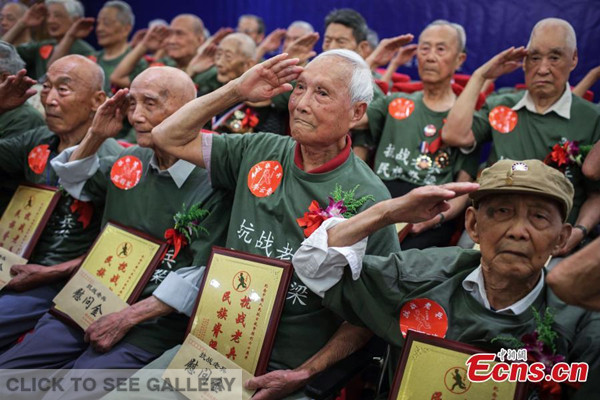Thirty-three veterans from the War of Resistance Against Japanese Invasion (1937–1945) attend an event to mark the 78th anniversary of the July 7 Incident, in Nanjing, East China's Jiangsu province, July 5, 2015. (Photo: China News Service/Yang Bo)
The fierce and bloody experience of war is engraved in the memories of many Chinese veterans.
Li Wende, 88, lives in a small village nestled in the mountains near the China-Myanmar border. Since World War II ended in 1945, Li has taken one to two hours out of his day to sit down and reflect on the atrosities he witnessed on Songshan Mountain.
Chinese soldiers regained the vital area, between Myanmar and Yunnan Province, Southwest China, in 1944 after three months of fierce fighting against the Japanese. Thousands died.
"The Japanese attacked us from above and on the ground, bodies were strewn everywhere. We could not carry the fallen, they were left to rot," recalled the veteran.
"Some of our troop went back to collect some of the bodies in the dead of night, and their clothes were full of maggots," he said.
In a park in Baoshan District, Shanghai, visitors leave flowers at a monument in memory of a Kuomintang battalion led by Yao Ziqing, who fought Japanese soldiers to the last bullet in September 1937.
All the battalion's 600 soldiers, including 29-year-old Yao, died in the week-long fight, part of the Battle of Songhu, also known as the Battle of Shanghai. It was one of the bloodiest battles of WWII in China.
In 1942, China sent 100,000 soldiers to Myanmar to fight the Japanese.Liu Guiying was a nurse with the expedition.
In one battle, Japanese troops cut off access to a main road used by Chinese soldiers to return to China, forcing them to make a detour into the remote mountain range along the border.
"In order not to delay the withdrawal of the majority of the troops, more than 1,000 injured or sick soldiers asked for gasoline to self-immolate. They would rather die than be taken prisoners of war," remembered Liu, 95, who now lives in east China's Anhui Province.
More than 10,000 were killed in Japanese airstrikes in Baoshan City, Yunnan, on May 4, 1942. Almost half of the city's population died on that one day.
"So many students were killed or injured. Their sobs and wails filled the air," said Geng Deming, 81, who lost his 5-year-old sister on that ill-fated day.
"I rushed home from school, past rivers running red and bodies piled up under bridges," recalled Geng, who is also a war historian.
More than 35 million Chinese troops and civilians were killed or injured in the anti-Japanese war, official statistics show.
The main force of the Japanese army was in China during World War II, said Tan Huwa, a researcher with Yan'an University in Yan'an, a revolutionary base in Shaanxi Province, northwest China.
China's fierce resistance prevented Japan from attacking the Soviet Union or sending more forces to the Pacific battlefield, disrupting Japan's war plan, he said.
His opinion is echoed in "China's War with Japan, 1937-1945: The Struggle for Survival" , written by Rana Mitter, a professor of history at the Oxford University, the United Kingdom.
Mitter highlights the vital part China's resistance against Japan played in WWII.

















































